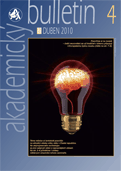Three professors from the Czech Academy of Sciences on the List of the Most Cited Scientists of the World

18 Sep 2015
Conference on Democracy (not only) in Muslim Countries

17 Sep 2015
New possibilities of imaging molecules with atomic force microscope

6 Aug 2015
Scientists from the Institute of Physics of the Czech Academy of Sciences (CAS) together with colleagues from Osaka University in Japan presented in the journal Nature Communications [1] a new method that significantly advances the current possibility for atomic force microscopes to image chemical structures of individual molecules. Recent developments in scanning microscopy enable us to resolve the chemical structure of individual molecules deposited on surfaces. The sub-molecular resolution of individual molecules opens up entirely new possibilities in the study of physical and chemical properties of molecular nanostructures. However, it was possible to carry out these measurements only at very low temperatures close to absolute zero with specially modified microscope tips.
Chile and Canary Islands selected for the construction of the largest gamma-ray observatory

21 Jul 2015
The Legacy of Charlemagne

30 Jun 2015
Hunting for insects with a crane: forest ecology research on six continents will be spearheaded by the Czech Academy of Sciences

22 Jun 2015
How would forests entirely devoid of insects look like? And why most of insect species prefer life in tropical jungles to temperate zone forests? Questions asked by a curious child, perhaps, but also by international research team from the Czech Academy of Sciences, recently supported by the European Research Council to study forests all over the world, and build a new canopy crane in the rainforests of Papua New Guinea.
International conference “The Present and Future of Institutions of Non-University Research”

28 May 2015
Non-university research has a future
The future of non-university research and its connection with higher education institutes, industrial research and business were the main themes of an international conference that the Czech Academy of Sciences organized on Wednesday, 27 May 2015 at its headquarters. The roundtable discussions were attended by the elite of European science – Martin Stratmann (president of the most important German scientific institution, the Max Planck Society), Peter Haslinger (director of the Herder-Institute, Leibniz Association), Soren Wiesenfeldt (director of research at the Helmholtz Association), Ed Noort (vice-president of ALLEA – All European Academies) and other guests from Italy, Great Britain and the USA.
The Czech Academy of Sciences at EXPO 2015

22 May 2015
On 1 May, the gates of the world EXPO 2015 with the motto “Feeding the Planet, Energy for Life” opened in Milan. The raising of the exposition’s flags was accompanied by the tones of Antonín Dvořák’s New World Symphony and precisely the Czech pavilion was selected by the Italian media as one of five to be recommended for a visit. Their last discoveries are then presented also by two institutes of the Czech Academy of Sciences. The Institute of Organic Chemistry and Biochemistry (IOCB) in the Laboratory of Life presents research aimed at seeking new human medications for lifestyle diseases. A human cell as a miniature chemical plant in which thousands of events take place necessary for the healthy functioning of the organism was rendered for the Laboratory of Life and the IOCB by the artist Jakub Nepraš.
Public Lecture with Nobel Laureate Finn Kydland

15 Apr 2015
Prof. Finn E. Kydland (University of California, Santa Barbara), 2004 Nobel Laureate in Economics, will give a public lecture on "Innovation and Capital Formation in Today's Policy Environment".
Jan Švejnar wins 2015 IZA Prize in Labor Economics

14 Apr 2015
The 2015 IZA Prize in Labor Economics goes to Jan Švejnar, the James T. Shotwell Professor of Global Political Economy and Director of the Center on Global Economic Governance at Columbia University’s School of International and Public Affairs, New York and a chairman of the Executive and Supervisory Committee of CERGE-EI in Prague. Czech economist was recognized for his work on economic issues in labor, development and the transition from socialist to market economies.







